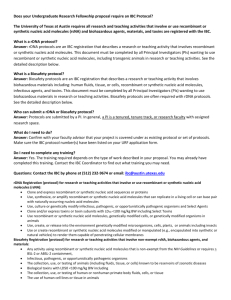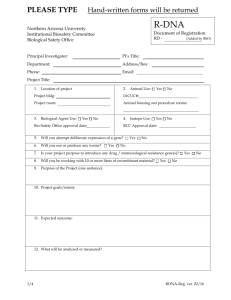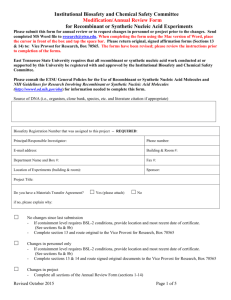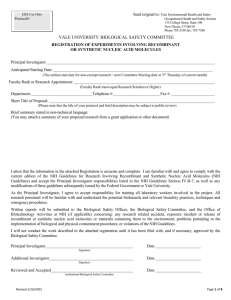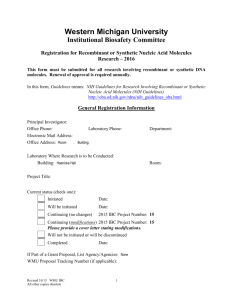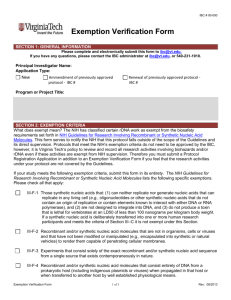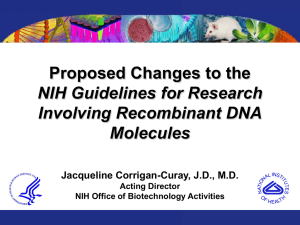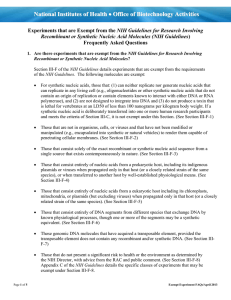R-DNA & Synthetic Nucleic - Environmental Health and Safety
advertisement
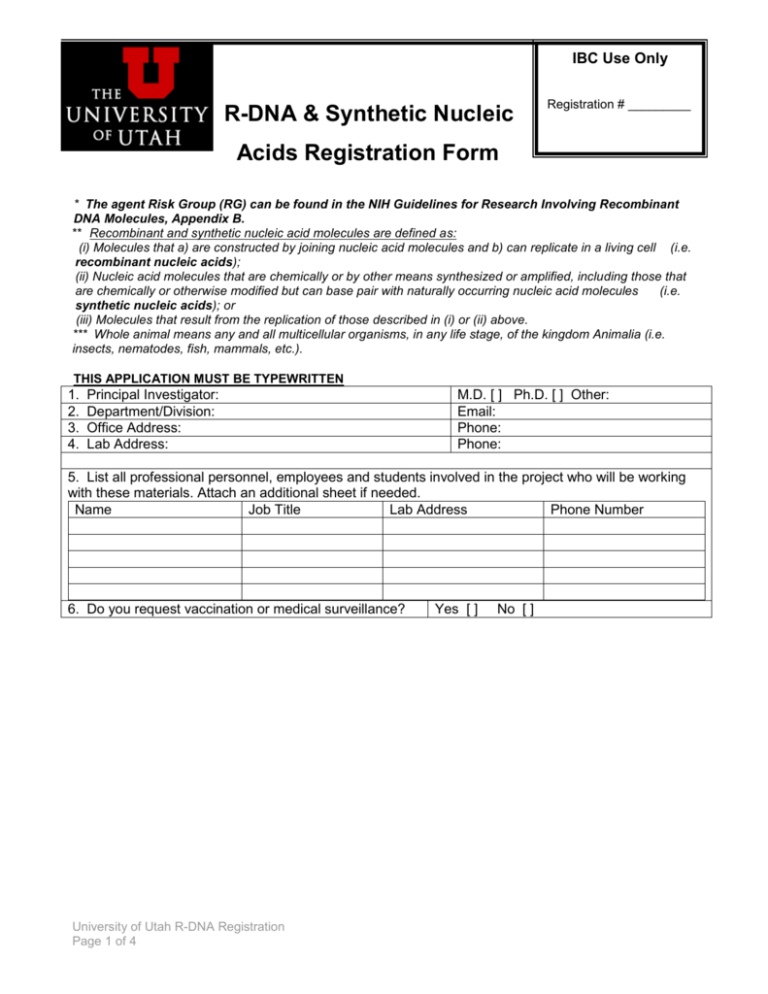
IBC Use Only R-DNA & Synthetic Nucleic Registration # _________ Acids Registration Form * The agent Risk Group (RG) can be found in the NIH Guidelines for Research Involving Recombinant DNA Molecules, Appendix B. ** Recombinant and synthetic nucleic acid molecules are defined as: (i) Molecules that a) are constructed by joining nucleic acid molecules and b) can replicate in a living cell (i.e. recombinant nucleic acids); (ii) Nucleic acid molecules that are chemically or by other means synthesized or amplified, including those that are chemically or otherwise modified but can base pair with naturally occurring nucleic acid molecules (i.e. synthetic nucleic acids); or (iii) Molecules that result from the replication of those described in (i) or (ii) above. *** Whole animal means any and all multicellular organisms, in any life stage, of the kingdom Animalia (i.e. insects, nematodes, fish, mammals, etc.). THIS APPLICATION MUST BE TYPEWRITTEN 1. 2. 3. 4. Principal Investigator: Department/Division: Office Address: Lab Address: M.D. [ ] Ph.D. [ ] Other: Email: Phone: Phone: 5. List all professional personnel, employees and students involved in the project who will be working with these materials. Attach an additional sheet if needed. Name Job Title Lab Address Phone Number 6. Do you request vaccination or medical surveillance? University of Utah R-DNA Registration Page 1 of 4 Yes [ ] No [ ] 7. Project Title: 8. Grant # (if applicable): Is this an NIH grant or contract number? Yes [ ] No [ ] If yes, NIH funding institute or center: NIH program officer contact information (name, email, phone): 9. Are you using Recombinant DNA? Yes [ ] No [ ] Are you using Synthetic Nucleic ACID Molecules? 10. Will known or potential human, animal, or plant pathogens be used in this research (e.g., adenovirus, adeno-associated virus, lentivirus, vaccinia virus)? Yes [ ] No [ ] Yes [ ] No [ ] If yes, please specify the genus, species, and strain: Proposed Containment Level: BSL1 [ ] BSL2 [ ] BSL2 enhanced [ ] BSL3 [ ] Vector? Acquired from: 11. Cloning vector to be used (plasmid, viral vector, etc.)? Check here if not applicable [ ] 12. Will the vector contain more than twothirds of any eukaryotic viral genome? 13. Is a helper virus used? 14. Specify the gene(s) of interest to be inserted, synthesized or amplified into the recombinant. Proposed Containment Level: BSL1 [ ] BSL2 [ ] BSL3 [ ] A construct map must be attached for Yes [ ] No [ ] all vectors used in this experiment. Yes [ ] No [ ] If yes, a retrovirus? Yes [ ] No [ ] Name of gene sequence(s)? Acquired from: Source (human/animal/microbial)? 15. Will experiments involve the cloning of Yes [ ] No [ ] toxin molecules with an LD50 of less than 100 nanograms per kilogram body weight? 16. Will experiments involve the deliberate Yes [ ] No [ ] transfer of a drug resistance trait to microorganisms, other than antibiotic resistance genes used for cloning in bacteria? 17. Will you have more than 10 liters of recombinant DNA culture or synthetic nucleic acid molecules (all sources) in your lab at any given time? If yes, please explain: 18. Do laboratory personnel work with human cell cultures, blood, tissues, organs, or body fluids? If yes, please specify: Yes [ ] No [ ] If yes, please explain: Yes [ ] No [ ] 19. Please check all situation(s) that apply to your project: Host-Vector Systems Escherichia coli Yes [ ] No [ ] Strain: Risk Group*: Other Bacteria Yes [ ] No [ ] Strain: Risk Group*: Yeast Yeast Artificial Chromosome (YAC) Yes [ ] Yes [ ] No [ ] No [ ] Strain: Specify: Cell and Tissue Culture Will recombinant or synthetic DNA molecules be propagated and/or maintained in cells in tissue/cell culture? Yes [ ] Whole Animals** Will whole animals be used in this project? Yes [ ] No [ ] University of Utah R-DNA Registration Page 2 of 4 Species: No [ ] Cell Line: Will whole animals be exposed to recombinant or synthetic DNA molecules/ modified microorganisms? Does this research involve generating transgenic animals? Will transgenic animals be purchased or transferred as part of this research? Has the Institutional Animal Care and Use Committee been notified? Yes [ ] No [ ] If yes, where will the animal work be conducted (bldg & room #)? Proposed containment level? ABSL1 [ ] ABSL2 [ ] ABSL3 [ ] Yes [ ] No [ ] If yes, where will the transgenic animal work be conducted (bldg & room #)? Proposed containment level? ABSL1 [ ] ABSL2 [ ] ABSL3 [ ] If yes, please indicate the provider or recipient: Yes [ ] No [ ] Yes [ ] No [ ] If yes, IACUC Protocol # and IACUC Project Title: Yes [ ] No [ ] Species: Yes [ ] No [ ] If yes, please explain: Yes [ ] No [ ] If yes, IRB Protocol # and IRB Project Title: Whole Plants Will experiments be conducted with whole plants? Will plants, seeds, or plant parts be released into the environment or used in field tests? Human Subjects Human Subject Recipient? 20. Give specific reference for your experiment from the NIH Guidelines for Research Involving Recombinant DNA Molecules (e.g. Section III-D-1). The NIH Guidelines can be accessed at http://oba.od.nih.gov/rdna/nih_guidelines_oba.html This project falls under the following Section from the NIH Guidelines: 21. Please mark the box for all pieces of equipment that apply to this project: Centrifuge Vortex Mixer Specimen Transport Containers Blender Fermentor Vacuum Traps Sonicator Shaker Cell Sorter Homogenizer Ventilated or Filtered Animal Caging Hemocytometer 22. Attach a short, clear summary of your proposed recombinant DNA or synthetic nucleic acid experiments, in lay terms that will explain their essential features. Avoid jargon and excess technical detail. Address each of the following items and include any other data that you feel has important bearing upon the safety and the proposed containment level for this project. a. Provide a brief summary of your proposed experiments, and explain exactly why you are performing operations that make the experiments non-exempt from the NIH Guidelines. b. Briefly explain and justify the use of pathogenic organisms, synthetic nucleic acids or viral vectors listed in box 10 or 11. c. Identify and describe the risk(s) to humans associated with pathogenic organisms, synthetic nucleic acid molecules or viral vectors used in the experiment. d. Specifically identify the gene(s) of interest, including a description of any associated hazards (i.e. genes that are chemically synthesized or amplified or genes that code for toxic, oncogenic, or otherwise hazardous peptides). e. Describe any special precautions required for containment and personal safety. Include procedures for transport or shipment of biological materials or animals associated with this project. f. If research involves the use of animals, identify and describe animal biosafety risks (i.e. excretion of virus from the animal, what will happen to the animal after the experiment, and any ecological University of Utah R-DNA Registration Page 3 of 4 advantages or environmental risks that experimental animals might acquire through the experiment). g. Please attach written lab-specific safety procedures that will be followed for all work BSL-2 and above (see NIH Guidelines Appendix G for Biosafety Level criteria). Procedures must address both safety to laboratory personnel and containment of laboratory animals. h. For experiments that will be conducted at BSL-2 or above, please describe the experience and training of all individuals listed on this registration form that qualify them to work at the proposed containment level. For individuals who lack training and experience, please describe your plan to train them to a level of proficiency that will allow them to work safely under these conditions. 23. I hereby apply for approval of my plans for experiments involving recombinant DNA and/or synthetic nucleic acid molecules. I am familiar with, and agree to abide by, the provisions of the current NIH Guidelines (April 2002 Federal Register (or later) and appendices), and any other specific NIH or University of Utah instructions pertaining to the proposed project. I agree to provide the IBC prompt written notification of any significant changes in these protocols or of any major accidents involving recombinant DNA and/or synthetic nucleic acid molecules. I agree to comply with NIH requirements pertaining to shipment and transfer of recombinant DNA and/or synthetic DNA materials. I accept responsibility for the safe conduct of work with this material as indicated on any page of this form, and in any additional information submitted in connection with this application, or updating or revising this application. I will ensure that all personnel receive appropriate training in regard to proper safety practices and personal protective equipment needed for this work and that all building occupants are educated when warranted. I certify that all herein provided information, and any subsequent information submitted in connection with this application, is accurate and complete. Principal Investigator (signature/date):_____________________________________________________ Send a copy of completed forms to the following individual: Biosafety Specialist Environmental Health & Safety University of Utah 125 S. Fort Douglas Blvd., Building 605 Salt Lake City, Utah 84113 Office (801) 581-6590 Fax (801 585-7240 e-mail biosafety@ehs.utah.edu 10/31/2010 University of Utah R-DNA Registration Page 4 of 4


